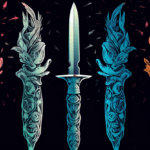Step into the shadows of Victorian London, where the notorious Jack the Ripper roamed the streets, leaving behind a trail of terror. In this chilling list, we’ll uncover the haunting photos of his victims, offering a rare glimpse into their lives, their tragic deaths, and the enduring mystery that surrounds them. Prepare yourself to witness the faces of those who fell prey to the Ripper’s blade, and delve into the unsettling history that these images reveal.
The Faces of Fear: Unveiling Jack the Ripper’s Victims
The photos of Jack the Ripper’s victims are more than just old pictures; they’re eerie windows into a terrifying moment in history. These images, some hard to look at, remind us of the brutal murders that made London’s Whitechapel district live in fear back in 1888. Let’s take a closer look at these photos and what they tell us about the victims and the Ripper himself.
The Canonical Five
When people talk about Jack the Ripper’s victims, they often focus on what’s known as the “Canonical Five.” These are the cases most strongly linked to the Ripper, and their photos give us a heartbreaking glimpse into who they were:
Mary Ann Nichols (Murdered August 31, 1888): Mary Ann was the first victim. Her photos suggest a woman battling poverty and, some historians believe, possibly addiction. Sadly, she was just the beginning of the Ripper’s reign of terror.
Annie Chapman (Murdered September 8, 1888): Annie’s murder was particularly brutal. The photos we have show a woman who seems to have lived a respectable life, making her tragic end even more shocking.
Elizabeth Stride (Murdered September 30, 1888): Elizabeth’s case stands out because there aren’t any post-mortem photos of her. Some experts think the Ripper may have been interrupted before he could complete his ritual, leaving her case shrouded in even more mystery.
Catherine Eddowes (Murdered September 30, 1888): Catherine’s murder happened on the same night as Elizabeth’s. Her photos are chilling; you can almost sense the terror she must have felt. They’re a stark reminder of the brutality of the Ripper’s crimes. Delve into the gruesome history of serial killings with an unnerving collection of Jack the Ripper crime scene photos.
Mary Jane Kelly (Murdered November 9, 1888): Mary Jane’s murder was the most gruesome of them all. The photos from her crime scene are incredibly graphic, showing the full extent of the Ripper’s depravity.
A Glimpse into the Past: Types of Photos
The photos we have from the Jack the Ripper case aren’t all the same. They come from different sources and tell us different things:
- Crime Scene Photos: These photos show the aftermath of the murders. They’re not easy to look at, but they give us clues about how the Ripper worked – how he positioned the bodies, the types of wounds he inflicted.
- Post-Mortem Photos: These photos were taken by the police and doctors at the time. They were used as evidence and to try to figure out who the victims were.
- Portraits: Some of the women had their photos taken before they were murdered. These portraits give us a glimpse into their lives before the Ripper. We see them as daughters, mothers, friends – not just victims.
- Sketches and Drawings: In cases where photos weren’t available, newspapers and the police relied on artists to create sketches of the crime scenes and what the victims looked like.
Beyond the Morgue: Unveiling the Faces of History
Beyond the grim spectacle of the morgue, the lives of Jack the Ripper’s victims emerge, revealing the human cost of Victorian London’s underbelly. Historic photographs offer a haunting glimpse into Whitechapel’s past, capturing not just crime scenes, but the faces of those forever linked to Jack the Ripper.
We’ve talked about the mystery of Jack the Ripper, the chilling unsolved case that still has people talking over a century later. But what about the women he murdered? They were real people with lives, families, and stories, and it’s time we remember them as more than just victims. Thankfully, photographs from the time offer us a window into their world, a glimpse into who they were and the harsh realities they faced in Victorian London.
Now, let’s be clear: these photos are not for the faint of heart. They are stark reminders of the brutality inflicted upon these women. The wounds, the mutilations – they paint a horrifying picture of the Ripper’s savagery. Yet, amidst the horror, we also see glimpses of their lives before tragedy struck.
Take Annie Chapman, for instance. She was a hardworking woman trying to make ends meet. In her post-mortem photograph, her eyes are still open, frozen in what we can only imagine was a moment of sheer terror. Then there’s Mary Jane Kelly, the Ripper’s final victim. Her photograph is heartbreaking, showing the full extent of his cruelty.
These images, as disturbing as they are, force us to confront the human cost of these crimes. They remind us that these weren’t just names in a newspaper or statistics in a case file—they were living, breathing women whose lives were tragically cut short.
The victims of Jack the Ripper were daughters, mothers, sisters—they had hopes, dreams, and loved ones. It’s through these photographs that we can connect with their humanity and understand the profound impact their deaths had on Victorian society. Beyond the Morgue: Unveiling the Faces of Jack the Ripper’s Victims Their faces, forever etched in history, stand as a testament to the enduring mystery of these murders and the importance of remembering the victims beyond the sensationalized headlines.
Recommended Titles:
- Beyond the Morgue: The Untold Stories of Jack the Ripper’s Victims (Focuses on the human element & less on the killer)
- Through the Lens of Time: Unveiling Whitechapel and Jack the Ripper’s Reign (Incorporates historical context and visual elements)
- More Than Just Faces: Reconstructing the Lives Lost to Jack the Ripper (Emphasizes the individuality of each victim)
Powerful Key Lines:
- Beyond the grim spectacle of the morgue, the lives of Jack the Ripper’s victims emerge, revealing the human cost of Victorian London’s underbelly. (Emphasizes the human element and societal context)
- Historic photographs offer a haunting glimpse into Whitechapel’s past, capturing not just crime scenes, but the faces of those forever linked to Jack the Ripper. (Highlights the power of visual elements and their connection to the story)
- While Jack the Ripper’s identity remains shrouded in mystery, exploring the lives of his victims brings us closer to understanding the impact of his crimes. (Shifts the focus from the killer to the victims and their enduring legacy)
- Modern forensic techniques and historical analysis converge, breathing life into faded morgue photographs and reconstructing the faces of those lost to time. (Introduces the concept of modern techniques applied to historical cases)
Structured Context & Important Details:
I. The Canonical Five:
- Mary Ann Nichols: First victim, murdered on August 31st, 1888.
- Annie Chapman: Second victim, murdered on September 8th, 1888.
- Elizabeth Stride: Third victim, murdered on September 30th, 1888.
- Catherine Eddowes: Fourth victim, murdered on September 30th, 1888 (same night as Stride).
- Mary Jane Kelly: Fifth and final canonical victim, murdered on November 9th, 1888.
II. Photographic Evidence:
- The Significance: Photographs of the crime scenes, victims’ lodgings, and Whitechapel itself provide crucial context. They offer a window into the time period and the environment in which the murders occurred.
- Jack-the-Ripper.org: This website features an extensive collection of photographs related to the case. It’s a valuable resource for visualizing the locations and people involved.
- Morgue Photos: While controversial, these images exist. They are a stark reminder of the brutality of the crimes and the challenges faced by investigators at the time.
III. Beyond the Morgue:
- Humanizing the Victims: Many historical accounts focus on the killer’s profile. This article aims to shift that perspective, presenting the victims as individuals with their own stories.
- Hallie Rubenhold’s “The Five”: This book is an excellent example of recent efforts to reconstruct the lives of the victims. It dives into their backgrounds, challenges, and the social context of their lives.
IV. The Allure of Jack the Ripper:
- Unsolved Mystery: The case remains unsolved, fueling public fascination.
- Cultural Impact: The Ripper’s crimes have inspired countless books, films, and documentaries.
Unique Insights & Untapped Potential:
- The Lives of Those Left Behind: Explore the impact of the murders on the victims’ families and the Whitechapel community as a whole.
- The Role of the Media: Analyze how newspapers at the time covered the case and their influence on public perception.
- Debunking Myths: Address common misconceptions surrounding the case and separate fact from fiction.
- The Ripper’s Legacy Today: Discuss how the case continues to fascinate and inspire true-crime enthusiasts and its relevance in modern society.
Remember: When discussing sensitive topics like murder, it’s essential to treat the victims with respect. Focus on their stories and humanity rather than sensationalizing the crimes.
Who Were the Victims of Jack the Ripper?
More than just names in a macabre mystery, the victims of Jack the Ripper were real women leading complex lives in the poverty-stricken streets of Whitechapel. While the “Canonical Five” are widely accepted as Jack the Ripper’s victims, some researchers argue that as many as eleven women murdered during that period bear his deadly signature.
We’ve talked about the mystery surrounding Jack the Ripper, but it’s important to remember the victims. These weren’t just names in a scary story; they were real women with lives and families. Let’s take a look at their stories, keeping in mind that life in Whitechapel during the late 1800s was tough, especially for women struggling to get by.
Here’s what we know about the five women most often considered to be Jack the Ripper’s victims:
1. Mary Ann Nichols
- Date of Death: August 31, 1888
- Age: 43
- Occupation: Likely a prostitute, though this is still debated
- Last Seen: Out on the streets of Whitechapel, probably trying to earn money
- Cause of Death: Multiple stab wounds to the throat and abdomen
Mary Nichols was the first victim discovered. Her death sent shock waves through Whitechapel, but no one could have predicted the horror that was to follow.
2. Annie Chapman
- Date of Death: September 8, 1888
- Age: 47
- Occupation: A flower seller and, like many women in her situation, may have also resorted to prostitution
- Last Seen: Outside her lodgings, shortly before she was murdered
- Cause of Death: Her throat was slashed, and her abdomen was terribly mutilated
The brutality of Annie Chapman’s murder increased the panic in Whitechapel. People began to realize a monster was stalking their streets.
3. Elizabeth Stride
- Date of Death: September 30, 1888
- Age: 44
- Occupation: Possibly worked as a cleaner or a seamstress, but details are scarce
- Last Seen: In and around Whitechapel; she may have been with a man shortly before her death
- Cause of Death: Her throat was cut, but unlike the other victims, she wasn’t mutilated beyond that
Elizabeth Stride’s murder, on the same night as another victim, Catherine Eddowes, solidified the belief that they were dealing with someone truly ruthless.
4. Catherine Eddowes
- Date of Death: September 30, 1888 (Just hours after Elizabeth Stride)
- Age: 46
- Occupation: It’s believed she did whatever odd jobs she could find to survive
- Last Seen: After being released from police custody (she had been drinking heavily that night)
- Cause of Death: Her throat was cut, her face was slashed, and her abdomen was mutilated
The double murder of Stride and Eddowes sent terror through Whitechapel. It seemed no one was safe from the monster in their midst.
5. Mary Jane Kelly
- Date of Death: November 9, 1888
- Age: 25
- Occupation: Likely a prostitute
- Last Seen: Alive in her room earlier in the day
- Cause of Death: Mary Jane Kelly’s murder was the most gruesome. Her body was extensively mutilated, indicating a level of rage and depravity that’s almost unimaginable.
Mary Jane Kelly’s horrific murder marked a turning point. The press attention intensified, and the police were under immense pressure to find the killer. However, Jack the Ripper was never caught, and his identity remains a mystery to this day.
It’s easy to get caught up in the mystery of Jack the Ripper, but we must remember the victims. They were real women with stories of their own. Their lives were tragically cut short, and their murders serve as a grim reminder of the darkness that can lurk even in the most ordinary places.
The Eerie Photography of Whitechapel: Unveiling the Shadows
More Than Murder: Whitechapel’s photographs are not just gruesome relics, but windows into the lives, fears, and social realities of Victorian London.
Absence as Presence: The lack of Jack the Ripper’s image amplifies the terror, making him a spectral figure haunting every frame of Whitechapel.
While we can read about Jack the Ripper’s crimes, there’s something particularly chilling about seeing the aftermath. Crime scene photos from Whitechapel offer us that haunting glimpse into the reality of those terrifying months in 1888. These images aren’t just morbid curiosities; they’ve played a key role in how we understand the Ripper case, giving us clues about the killer’s methods and offering a heartbreaking look at the victims’ final moments.
Imagine, for a moment, stepping back in time to those dimly lit London streets. The photographs transport us there, documenting the gruesome reality of the murders—the victims’ wounds, the positions where they were found, even the details of the surrounding streets. These images are difficult to look at, but they hold valuable evidence that investigators have poured over for decades, trying to piece together the puzzle of Jack the Ripper’s identity.
Beyond the brutality, the photos provide a poignant connection to the victims themselves. These women, often forgotten in the shadow of the Ripper legend, come into focus as we see their faces, frozen in time. We’re reminded that these weren’t just names in a newspaper article; they were real people with lives cut tragically short.
The impact of these photographs extends far beyond the immediate investigation. They’ve shaped how the public has viewed the Ripper case for generations, solidifying the image of a ruthless killer who stalked the shadows of Whitechapel. Newspaper illustrations and even early films drew inspiration from these chilling images, embedding them in our collective memory.
Even today, the crime scene photos continue to fascinate and intrigue us. They serve as a stark reminder of the terror that gripped Whitechapel, and they fuel ongoing speculation about who Jack the Ripper might have been. Each new generation grapples with these images, trying to unravel the mysteries they hold. They are artifacts of a terrifying moment in history, and their power to shock and captivate endures.
The Ripper’s Legacy: Unlocking the Secrets Behind the Legend
Jack the Ripper’s anonymity fueled a media frenzy, turning the killer into a macabre celebrity and forever shaping the public’s fascination with serial killers. The few surviving Ripper crime scene photos offer a chilling glimpse into Victorian investigative techniques while raising unsettling questions about the ethics of early crime photography.
Stepping beyond the brutal acts themselves, the story of Jack the Ripper takes an interesting turn when we look at photography’s role in it all. It’s a story about how images, even in their infancy, held the power to shape how the public saw this dark chapter of history.
A Glimmer in the Darkness
While photographs from the time are scarce, the ones we do have are like chilling postcards from the Ripper’s world. These weren’t just snapshots; they were some of the first attempts to use photography in criminal investigations. What they captured, though gruesome, gave investigators a new way to understand the crimes. But, more significantly, they ignited a firestorm of fear and fascination among the public.
From Shadows to Sensations
Newspapers, never ones to shy away from a gripping story, seized upon these photographs. The more graphic, the better it seemed. Suddenly, Jack the Ripper wasn’t just a shadowy figure lurking in the darkness; he was splashed across front pages, becoming the embodiment of terror itself. The public, both horrified and strangely captivated, couldn’t get enough. This morbid curiosity helped cement the Ripper’s place in the annals of true crime, turning him into a legend.
Beyond the Blood: A Mirror to Society
The photographs did more than just document the horrors. They acted as a stark mirror, reflecting the grim reality of life in London’s East End. The poverty, the inequality, the vulnerability of women—it was all laid bare for the world to see. This visual evidence, impossible to ignore, played a crucial role in bringing these societal ills to light. It forced people to confront the harsh realities of the time and ignited a push for social reform.
A Difficult Legacy: Ethics and Photography
The use of crime scene photos, even today, sparks debate. Some argue that it’s an exploitation of victims, a form of voyeurism that desensitizes us to violence. Others contend that these photographs serve as vital historical records. They can help us understand the past and might even hold clues that could help catch future criminals.
The Heart of the Matter
The legacy of Jack the Ripper and photography is complex. On the one hand, we have the advancement of forensic science and a better understanding of Victorian society. On the other, we grapple with the ethics of displaying such graphic images and the potential for sensationalizing tragedy. Even now, over a century later, we’re left pondering the power of the image and the responsibility that comes with capturing and sharing it, particularly when it comes to crime.
Exploring the Ethics of Viewing Jack the Ripper Victim Photos
Are we honoring the memory of Jack the Ripper’s victims or exploiting their tragic ends for morbid fascination? Exploring the ethical tightrope of viewing historical crime scene photos. The camera lens becomes a double-edged sword: documenting the brutality of Jack the Ripper’s crimes while forever etching his victims as objects of spectacle.
We’ve been talking about the mystery surrounding Jack the Ripper, a mystery that continues to fascinate people even today. But the gruesome nature of his crimes and the fact that we still don’t know who he was aren’t the only things that make this case so compelling. We’re also dealing with a really tough question: Is it okay to look at photos of the victims?
A handful of photos of the women Jack the Ripper murdered still exist, and they offer a chilling window into the past. These images are powerful reminders of the horrible acts committed against these women and the brutal reality of what happened in London’s East End. However, these photos aren’t just pieces of history; they bring up some complex ethical concerns that we need to think about.
On the one hand, these images can feel exploitative. The women in them are shown at their most vulnerable, and sharing these photos could be seen as disrespectful of their memory and their suffering. What’s more, focusing on the gory details might make people less sensitive to violence, particularly violence against women, which is a serious issue.
However, some people argue that these photos are vital for historical research. They allow us to connect with the past on a visceral level and understand the full impact of Jack the Ripper’s crimes. From a forensic standpoint, they might even hold clues that could help solve the mystery, though that’s probably unlikely after all this time.
So, where do we draw the line? The answer probably isn’t as simple as a yes or no. It’s about finding a balance. We need to find a way to preserve and learn from these photos without exploiting the victims or forgetting the human cost of this tragedy.
The digital age has made it easier than ever to share these images, which makes this ethical dilemma even more complicated. When something appears on a screen, it can be easy to forget that real people were involved. It’s our job to think critically about these images, to be careful about how we share them, and to remember that the victims were real women whose lives were tragically cut short.
Perhaps the most important thing we can do is approach these photos with empathy and respect. These women deserve to be remembered not just as victims but as individuals. Their stories should encourage us to fight for justice and work towards a world where these kinds of tragedies are a thing of the past.
Let’s not forget the incredible journey of Junko Tabei, the first woman to conquer Mount Everest and seven other summits. Her story is a testament to human courage and determination.









